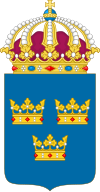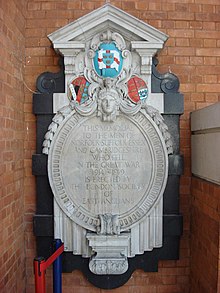Three Crowns
The emblem is often used as a symbol of official State authority by the Monarchy, the Riksdag, the Government of Sweden and by Swedish embassies around the world, but also appears in other less formal contexts, such as the Sweden men's national ice hockey team, who wear the symbol on their sweaters and hence are called "Three Crowns", and atop the Stockholm City Hall (built 1911–1923).
[1] One of several traditional explanations have suggested that Albert of Mecklenburg (1338–1412), who ruled Sweden 1364–89, brought the symbol from Germany.
This theory has been refuted by later research, namely, the announcement in 1982 of the discovery of a frieze in Avignon in southern France, estimated to date back to 1336.
The frieze was painted for an international congress led by the Pope and contains the symbols of all participant countries, including Sweden.
[4] The earliest known coat of arms featuring three crowns as a symbol of Sweden dates back to the 1330s and appears in a painted frieze in the Cardinal of Bayonne's palace in Avignon.
The symbol is known to have been placed atop the central tower of the castle Tre Kronor (Three Crowns) in Stockholm, destroyed by fire in 1697, no later than the early 16th century.
At the beginning of the 17th century the conflict was settled with both countries being allowed to use the Three Crowns in their coats of arms,[13] although in Denmark it had a less prominent place in the shield, and was officially referred to as a heraldic reminder of the former Kalmar Union.
The historical region of Galicia, now divided between Poland and Ukraine, had under Austro-Hungarian rule as its coat-of-arms a blue shield with three gold crowns as part of the design.
The German towns of Otterfing and Tegernsee in Bavaria use the three gold crowns on blue design on their coats-of-arms.
Practically identical to the three crowns of Sweden is that of the coat of arms and flag of the Province of Munster, a region in the southwest of Ireland.
A shield of three golden crowns, placed two above one, on a blue background, has been used a symbol of East Anglia for centuries.
The coat of arms was ascribed by mediaeval heralds to the Anglo-Saxon Kingdom of East Anglia and the Wuffingas dynasty which ruled it.
They were also included in the arms of the former Isle of Ely County Council, the Borough of Colchester and the University of East Anglia.
[23] The three gold crowns on blue design appears on the coat of arms of the Spanish city of Burriana in the Valencian Community, but, like Coutts & Co, is arranged one over two instead of two over one.















